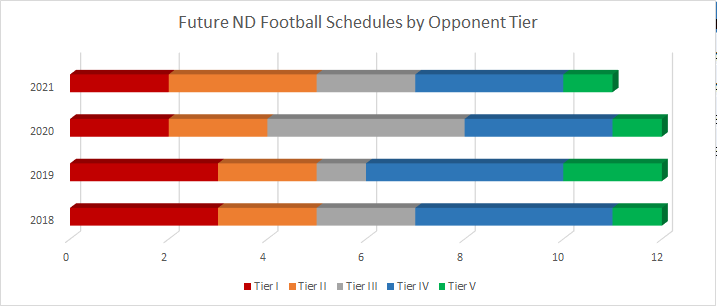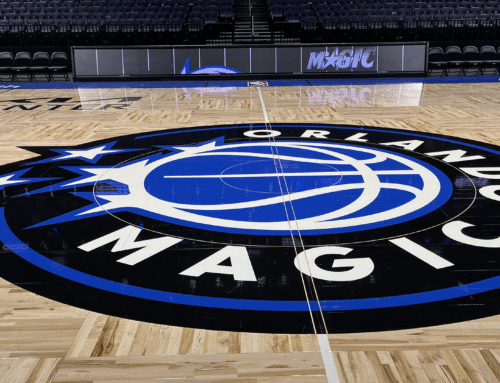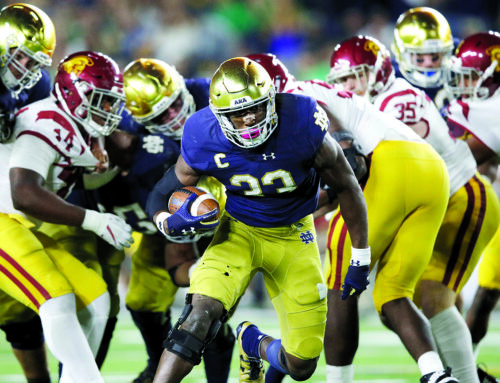Alternative clickbait headline – “Is Notre Dame scheduling itself out of future playoff contention?”
The schedule for Irish football has become a hot topic in recent months, following the announcements of a two-game series with Wisconsin in 2020/21 and moving next year’s scheduled home game against Syracuse to Yankee Stadium. This debate is nothing new – either within the community of Notre Dame fans or more broadly arguing resumes in these formative years of the College Football Playoff. So what do we now know about making the playoff, scheduling, and implications for ND moving forward?
A Framework for Comparing Schedules
A helpful and common way to think about scheduling and opponents is using a tier system. Scheduling requires enough advance notice that it’s impossible to predict the ebbs and flows of individual programs. I’m sure when Jack Swarbrick scheduled a home and home with Texas he thought he was getting a Big 12 contender, not a Longhorn teams= that would finish in the bottom half of the conference. The best way to attempt to balance a schedule is to look at historical program performance, knowing that some years things will break favorably, some years you’ll roll snake eyes. Based on head coaching and recent recruiting programs can move over time from one tier to another (Clemson recently jumping to a top tier for example, or Nebraska moving downward).
Defining these tiers, I find there’s value in more tiers and detail versus less. So I’d propose the following definitions:
Tier I: Traditional championship-caliber programs – teams that are expected to compete for the playoff each year, recruit consistently at a high level, and as a result have talent equal or better than Notre Dame. I won’t be comprehensive when listing teams, but this tier would include Alabama, Ohio State, USC, Clemson, FSU, UGA, Texas, and Oklahoma.
Tier II: Top power five programs consistently near the top of their conferences, but not quite Tier I level in historical success and talent. Each tier moving down includes more teams, and current programs like Wisconsin, Virginia Tech, and Stanford are probably strong archetypes of this tier. In a draft where each participant wanted to select the most future playoff participants, these are teams 10-25.
Tier III: Mid-level power five programs – these programs are inconsistent, do not regularly win conference titles, but are not usually found at the bottom of the standings either. They may play spoiler occasionally and make runs if they unearth an elite talent or find a strong head coach – representatives here would include Louisville, Arkansas, Arizona, and recent Northwestern. A strong sustained effort from a group of five program could also nudge their way in here – present Boise State or USF – but fewer than a handful at a time likely qualify.
Tier IV: Bottom-dwelling power five programs and plucky group of five schools (hello, AAC!). Representative teams would be Kentucky, Indiana (although improving!), Duke, Iowa State, Navy, and much of the AAC and Mountain West.
Tier V: Group of five programs that have nothing going for them – at best they possibly make a bowl appearance from winning games in a weak conference, but are at extreme talent deficiencies. Teams like Rice, UMass, most MAC and Sun Belt teams, New Mexico State, and FCS opponents belong here.
What matters for the playoff committee?
There is still a lot to learn as the playoff committee considers different scenarios and challenges each year, and committee members begin turning over. Early on, though, there’s been a few consistent revelations.
Beating top teams counts the most: With a few years of data now, we can see the committee more than anything values wins over top teams. A single win over a top-10 team is likely enough for an undefeated power-five team to justify their place in the playoff. Wisconsin last season is a great example – despite their best wins in the regular season being Northwestern and Michigan, fringe top-25 teams at best, they would have been a lock with a win over Ohio State in the B1G Championship. Iowa in 2015 would have similarly been in with just one top win.
Even this season’s seeding (although ultimately meaningless between the #2 and #3 seed) gives us confirmation. Oklahoma and UGA had comparable resumes, but with the Sooners owning a better win (at Ohio State) they edged out the Dawgs. The only way to beat these top teams, outside of the seeming guarantee to play one if you have a conference title, is to ensure you have 1-2 on your schedule.
Feasting on cupcakes can kill margin of error: While top wins matter most, a schedule also can’t be filled with cupcakes. Baylor has been notoriously scheduling themselves out of playoff contention as soon as they pick up a single loss with garbage out of conference schedules. Scraping the bottom of the barrel of FCS teams and some of the worst group of five programs is a surefire way to bomb strength of schedule ratings as well most of the key stats it’s clear the committee looks at (Strength of Resume, for example).
Mediocre teams filling up the schedule can work: Playing games against middling and poor P5 teams doesn’t really move the needle much either way for the committee, it seems. Win those games without letting an inferior opponent keep it close, and they are baby steps in helping your playoff bid, because you didn’t lose and won’t get penalized. Blow out a few of those teams and it can be an even bigger added bonus and enough to cement a resume if a team has the requisite big win or two so no one can argue they ain’t played nobody.
Alabama last season is an instructive case – prior to the playoff, their best wins were over #17 LSU and #23 Mississippi State. The Tide played one FCS squad but mostly just piled up wins against unranked but mostly P5 or upper G5 teams – FSU, Vandy, Ole Miss, Arkansas, A&M, Tennessee, Fresno State, and Colorado State. That wasn’t the intent of the schedule, but it worked out perfectly as Alabama snuck into the playoff despite not winning the SEC West.
Strength of schedule and resume only matter as a 1-loss tiebreaker: Notre Dame’s path to the playoff is fairly straightforward. Go undefeated, and the Irish are in given the opponents guaranteed to be on the schedule. Lose one game, and you have a chance – depending mostly on the strength and the quality of wins that year. Two losses and the Irish are out barring a miracle, even if they still have terrific wins and an extremely hard strength of schedule.
So Jack Swarbrick and the Irish have a challenging tightrope to walk – formulating a schedule that both maximizes their chances of winning at least eleven games, but that also has enough challenges and opportunities for top wins that Notre Dame will be able to beat out other one-loss teams for a spot if it comes down to that.
Recent and Future Notre Dame Schedules
Keep in mind we aren’t starting with a blank slate with Notre Dame’s schedule – we can write USC, Stanford, Navy, and five ACC opponents each season in permanent marker. While the ACC opponents vary each year, the rotation has worked out where most years (2 of 3) the Irish will play a Tier I opponent (Clemson or FSU), and usually another Tier II opponent as well (VT or Miami). The remaining three are likely split between Tier III programs (NC State, Louisville, Pitt) and Tier IV (Duke, Wake, Syracuse).
So already, you start most years with two Tier I teams (USC + FSU/Clemson), two Tier II teams (Stanford + ACC team), two-ish Tier III teams (ACC), and three-ish Tier IV teams (Navy + ACC). I do think Navy is arguably Tier III under Coach Ken, but I’m going to err on the side of undervaluing versus overvaluing teams for now.
Since it’s fresh in our minds, the 2017 season featured…
- Two Tier I teams (UGA and USC)
- Three Tier II teams (Stanford, Michigan State, Miami)
- Two Tier III teams (NC State, UNC)
- Three Tier IV teams (Navy, Wake, BC)
- Two Tier V teams (Miami (Ohio), Temple)
I think it’s safe to consider this a season where randomness certainly didn’t favor the Irish either. UGA was exceptionally strong, even for a top tier program, and NC State, MSU, and Miami achieved above their usual punching weight for much of the year. The only program that performed below their tier significantly was North Carolina.

So looking ahead at future schedules, how do these stack up? I’ll admit I struggled a bit with the Tiers of the ACC teams and not succumbing to too much recency bias, so you could probably move some of them around between Tier III and IV.
What is an ideal Notre Dame schedule?
Are these schedules too hard if your sole goal is making the playoff? I believe they are. Playing around five Tier I / Tier II opponents each year does give you the potential tiebreaking edge in strength of schedule – but again, that only matters if you can lose one game or less. Winning is hard, even against the Tier III and Tier IV teams of the world (I’m looking at you, playoff teams with losses to Iowa and Syracuse). Throwing in schedules like 2020, with USC, Clemson, Stanford, Wisconsin, and a portfolio of Tier III teams where a few are likely to be dangerous – it’s demanding a Bama-like squad to run that gauntlet when I don’t believe it’s necessary.

It will be fun and entertaining and profitable – and I’ll concede that Jack Swarbrick’s job when putting together a schedule factors in far more than just trying to make the playoff, although that should rank at the top of the list. Keeping that goal in mind, here’s my ideal schedule design for Notre Dame to make the playoff:
- Two Tier I teams: USC will always make the list, but you simply can’t put all your chickens in that basket (see 2015, when the Irish were lacking a top win in November despite having beaten Texas and the Trojans). Adding another historical top program, which is accomplished more often that not in the ACC rotation with FSU and Clemson, gives you two shots on goal and reduces the chances you miss a top team in a given year. The years where Notre Dame doesn’t play FSU or Clemson is when they should stagger creative matchups with other conferences – the UGA and future Ohio State home and homes, for example.
- Two Tier II teams, ensuring never more than four Tier I / II teams: Stanford gives you one every year, and most years the ACC gives you a second. On one hand I’m very excited to play Wisconsin at Lambeau Field, on the other I think it’s totally unnecessary for Notre Dame’s resume and more likely to hurt their playoff chances (via a loss) than help them (via the incremental resume boost of a win).
- One-Two Tier III teams: Again, the ACC deal accomplishes this many seasons. The Irish should be solid favorites in any non-VT, Clemson, FSU, or Miami game in the conference. No need to go overboard here scheduling another solid P5 team in the four empty spaces on the schedule each year.
- Five-Six Tier IV teams: Come on down, bottom of the ACC! Welcome, future series with Purdue! These are the types of games that are safe ground, keeping Notre Dame’s strength of schedule in solid shape while introducing low possibilities of a loss (in theory, not recent practice … I am trying hard but still have some memories left of sitting through a home loss to Duke).
- One Tier V team: Playing a home game a year against a cupcake is about right – ideally this comes in week one to let the team settle into a rhythm before competition quickly escalates. Notre Dame’s future week one opponents are Michigan, at Louisville, Navy (actually a good idea), at FSU, and at Ohio State. Good for television ratings, probably not my life in September.
So to make it real, here’s a hypothetical example, filling in teams for each Tier:
@ Navy (Tier IV)
vs Virginia (Tier IV)
vs FSU (Tier I)
@ Boston College (Tier IV)
vs Michigan State (Tier II)
vs Colorado (Tier IV)
BYE
vs USC (Tier I)
vs Purdue (Tier IV)
@ NC State (Tier III)
vs Duke (Tier IV)
vs Nevada (Tier V – Shamrock Series, New NFL Vegas Stadium)
@ Stanford (Tier II)
Geographic diversity, some challenges if things break right, but also a good balance – I think that’s ideal. Now, I hear the potential counter-arguments – the goal really isn’t just making playoffs, it’s also winning them, and if we pull a Sparty and show up just to get shut out by Bama, is it worth it? Scheduling aggressively is good for the sport, good for TV ratings and dollars, and good for recruiting.
But you can also schedule yourself into a disadvantage. If Notre Dame manages to put together a championship caliber team, wouldn’t you rather err on the side of ensuring they make the playoff versus a schedule that could prevent them from getting there? Even with a blowout loss to Iowa, if Ohio State scheduled Vanderbilt instead of Oklahoma, they’re probably in the 2017 playoff by virtue of wins over Wisconsin, Michigan State, Penn State, and Michigan (four Tier I and II teams, if we keep that measure). The type of schedule above I think is plenty tough enough to balance a strong chance at 11 wins with a great team AND solid opponents that would make the Irish worthy of a playoff berth even with one loss.





This is a fantastic read, and I agree with your comments basically wholeheartedly. As I said on a post earlier from Brendan, I hope folks in the athletic department read this website, because the analyses here seem spot-on.
One other point other point: we need to stop giving up home games, meaning it is time (past time really) to completely end the Shamrock Series. Even in your schedule sketched above, they’d be flying to and from Vegas then to and from Palo Alto in the course of a week. There’s no way that makes the team more likely to win the Stanford game. Unless you think some recruits are more likely to come to the school because they may play one or two games nearer their house over the course of their college career – which seems like a pretty big stretch – there is zero benefit to the football team to the games, and there is some attendant cost in terms of hassle, travel stress, loss of a home crowd, etc. It’s a totally unnecessary cash grab.
I agree that the Shamrock Series in its current form has seen its time come and go, especially if it comes at significant travel burden as you mentioned. If it really is about recruiting and taking the team national, you already play games each year on the west coast and southeast, and Northeast recruiting isn’t a problem, so I’d be trying to be in Dallas or Atlanta every year (even with the ACC deal, I don’t know that you can go wrong with that).
I’m not opposed to ways it might evolve – for example, doing some kind of permanent rotation between Soldier Field, Lucas il, and Ford Field to minimize travel? But those aren’t exactly recruiting hotbeds. I kept it in the schedule since it seems to be Swarbrick’s baby and also something that the University supports as they enjoy tying the football to other community events they do in those areas leading up to the game.
It’s funny, that 2020 schedule only has 4 Tier I/II games (the fewest of any season on the list), but it’s also the one that I’d most expect an average ND team to come out with the most losses.
-USC/Clemson is the most brutal 1-2 punch of any season (and USC is on the road).
-Stanford/Wisconsin is probably the 2nd toughest 3-4 punch (or toughest if you think Wisconsin is better than Michigan).
-Louisville is the toughest Tier III team we’ll play in any of the 4 seasons.
-2 Option teams, with the Navy matchup in NJ and the GT matchup on the road.
-4 Tier III teams (double any other season)
A preemptive “ow, my balls”
Great outlook. The scheduling debate always leads me back to independence. Does the pseudo-ACC membership really help (or hurt) either Notre Dame or the conference? I don’t know, it;s just is kind of there. They provide a decent variety of Tier II – IV teams to play at the expense of the mid-west rival games (Michigan, Michigan State, Purdue) that we don’t see played annually any longer but I’d wonder what the impact is positive or negative for the program.
My opinion is unpopular, but if the sole goal was to create a football powerhouse and give the best shot of competing for titles and playing in bigger games, in 2018 the best path for that is probably fully joining a conference. Stanford had 4 losses but was a FG away from playing in a NY6 game as PAC12 champs, after all. It’s not like beating FSU+Clemson would be easy, but the path is more defined and there’s more margin of error.
And I think the playoff will eventually move to where all power 5 champs are granted automatic inclusion into the playoff. If so, Notre Dame as independent is fighting for 3 crowded spots and they will go quick (one pencil in the SEC #2 team, another probably a Cinderella Gof5 team, then you have a snub team like tOSU this year or maybe an Oklahoma type if they don’t win). Not a great place to be and short of 12-0/11-1 ND is probably out every year.
Just some food for thought, nothing I’m really advocating for but I think the advantages would be there. Surely there are a ton of other factors to consider though.
Im starting to lean your way too. If all you have to do is win one of the top 4 conferences and it doesnt really matter if you have 1 or 2 losses, then that makes sense to me. Just join the ACC. What is independence REALLY doing for us?
I am slowly drifting in that direction. Of course, if they ever end up in the four super-conferences (where the conference title games are effectively national quarterfinals), then 100% I’d be on board.
Seems like the benefits of independence:
– Can schedule USC and Stanford every year/keep those rivalries up
– Can schedule Navy every year (uh, not sure that’s really a benefit)
– More flexibility to do fun games (e.g., Georgia, Wisconsin, etc.)
– More flexibility to schedule games in neutral site locations (not really sure that’s a great benefit, based on the experience with the Shamrock Series)
– NBC relationship
– Historical approach
– Get to be smug about it
Drawbacks:
– Makes it harder to win a national title
– Only have one concrete/tangible accomplishment to play for, which is often out of the question by November if not before (everyone else has conference championships)
I’m not really sure that the benefits are greater than the drawbacks when you factor in the relative import of the above.
Good points. Of it all, the NBC (and the $ that comes with it) probably is the most meaningful benefit and I’m sure toughest to surrender. I would have to think though that a conference (who get a ton of $ themselves with rights fees) would be willing to make Notre Dame a sweet offer to join up though. Who knows how feasible it would be with all the plans and commitments made, I’m sure it wouldn’t happen in the next 5 years even if they wanted to (which, they don’t) but just thinking outside the box a little.
My sense is that we are actually giving up money relative to, e.g., Big Ten teams. But the NBC relationship allows us to (1) basically always be on, even if the team stunk; (2) allows for a bit more ND hagiography, which, you know, I like; (3) provides a bit more certainty in scheduling because we can set our home gametimes ahead of time; and (4) gives us the “we have our own channel” sense of superiority, which is not nothing.
None of that untrue. I do wonder in 2018 how much that the similar points 1 and 4 matter. Yes, ND on NBC is an institution, but these days EVERY team is available on regular-ish channels for the entire country. You’re not going to see Alabama on CBS every single week (though, probably most) but they’re easy to find on TV every week. Ditto all the other big teams.
Obviously, 20-30 years ago, a national basic network is a huge, huge deal. Between local channels and cable I think I counted 14 games (down to more obscure SEC Network, Big10 Netwrk, CBS Sports Net, NBCSN, etc) on at a 1 PM on a Saturday that were available to me. Is having that fixed point on NBC (for half the schedule) really of that much value and benefit? Perhaps so, just an honest question.
Your point 2 for the celebration and boost factor of still having a network basically be the ND channel maybe bleeds over and matters too for this.
One thing we’ve lost with half-joining the ACC is scheduling flexibility. Now we still have a game or two that can change but without the 5 acc games they could change a lot more – that’s one of the biggest things I thought was always a benefit of independence was that over a handful of teams we’d play a lot of different games from around the country. Maybe it didn’t always work out that the schedule was so varied but that seemed to be the main benefit at any rate.
As much as Baylor’s scheduling kept them out of the playoffs with 1 loss. What it did do is get them a butt load of wins, and make everyone think they were really awesome because they were boat racing the worst teams in CFB. At some point people are just like “oh, they won 10 games 5 years in a row, they must be good.” That probably gives you a boost in ‘crootin’ as well, which can make you better.
If we scheduled more garbage teams, we could probably get them to host some exotic locations, like Navy does. Say Nevada at the new NFL stadium, but let that be their home game, since it would essentially be their home game anyway. Then we could do 7 home games, 1 neutral site, and 4 true road games. Our resume wouldn’t be impressive, but we would still build up some cache over a few years and despite having a very tough time making the playoff, we would finished ranked top 10 enough times that once we started scheduling for real we would get more credit from the “eye test”.
I would be totally down with us scheduling USC, Stanford, Navy, 5ACC teams, then all tier IV-V teams for like 3-4 years (no FCS). Win 10 games a year, then let BK retire, and we should be able to hire the hottest coach at that point. Then we start actually doing real schedules again. “Trust the process”
Although we can’t reschedule 2018, this is a great idea. And in general, why not just schedule two tough teams in an advantageous way (e.g. first week of october and first week of november) and remove the margin for the error by scheduling cupcakes. I don’t think beating Syracuse increases our playoff probability as much as losing to Syracuse decreases it.
And Michael, thanks for the great article.
Confused….
First, you wrote this “Tier IV: Bottom-dwelling power five programs…”
Later, you included a bottom-dwelling power five program in your Tier 1 for both 2018 AND 2019.
I’ll hang up and listen.
I really debate what tier they should belong in. They haven’t won anything substantial in a while, but until this year had put together a few consecutive top-10 classes, so I let them in.
The cut-off for Tier I is tough. The locks to me are Bama, Clemson, Ohio State, Texas (despite recent seasons), Oklahoma, USC, UGA, FSU, LSU, Auburn. That gets you to ten, and feels a little SEC heavy, but Auburn and LSU’s recruiting rankings are still top-10 more years than not and both have titles in the last decade. On the edge are Michigan, Penn State, and Florida, and I think you could argue both sides of all three programs.
Then you have some moving pieces – Oregon probably elbowed their way in for a few years but is now out, Washington could be considered in if Petersen continues to build things and be as consistent as he was at Boise, and UCLA could step up a level with Chip. A&M is spending money like they want to be Tier I but I don’t think they’ll get in there. Wisconsin I don’t think will ever recruit well enough to get in there, although they’ve been very impressive and have a cushy set-up in the B1G West.
Maybe you could use Stewart Mandel’s program pecking order (Kings, Barons, Knights, Peasants…) that he started in 2007 and updated in 2017:
https://www.foxsports.com/college-football/story/college-football-program-pecking-order-3-0-dividing-all-66-bcs-teams-into-four-tier-hierarchy-052517
I like those rankings. ND keeps doing just barely enough every few years to stay in that Kings category. The same could probably be said for Michigan and PSU, and he covers Miami explicitly in the article.
It sure feels like this right now
Kings: Bama
Barons: Clemson, tOSU
Peasants: Everyone else
I dont so much mind the NUMBER of teams in each category. I think ND does a decent enough job of balancing the SOS every year. I mean, we’re always in the top 15 or so of SOS for top 25 teams so I dont really mind who we’re playing. My biggest beef is always WHEN we’re playing select games.
We should never be playing anything over a T4 team the week after Navy(and Navy is the one team I wouldnt mind dropping from the sched entirely if they dont agree). If we cant get Wake after Navy or Duke or Indiana after Navy then we need to play them before the bye or at the end of the season.
That brings me to the other change…stop playing away games as the last game of the year against USC or Stanford. Sure 2012 really helped that because it thrust us into the NCG by beating a down USC team on the road to end the season, but November is crunch time and we need to be showcasing our dominance as much as possible there. Playing Miami followed by Stanford is suicide. Doing them both on the road is pure insanity. We need to be demanding these warm weather teams start coming up to South Bend the last week of the year and playing in OUR house.
Finally, space out the murderers rows. It seems like every other year or so it’s either we start the season with one or we end the season with one. We dont need to be playing B10 champions followed by the B10 runner up followed by an ACC championship game team to start the year just like we dont need to be playing Miami followed by NCST followed by Stanford to end it.
Those are some great ideas. I wonder if they could really be implemented or if there are too many obstacles from fitting it all together. Nevertheless, I’d like to see it done.
Thanks for the great article! I think you have a lot of good info and ideas, but as I recommend in another reply in these comments, consider using Stewart Mandel’s program pecking order for your tiers.
Not that Jack (who, based on the 18 stripes pics, seems to have to navigate a lot of rain storms) cares, but here are some of my suggestions for ND scheduling:
(1) Navy should be either the first or last game of the year – always.
(2) Instead of moving an ND home game to a far-off neutral site (that significantly increases travel), schedule a lower tier school as an away game and have that at a cool neutral site.
(3) Consider not finishing the year in California every year – why not host another game in South Bend in November and have some cold home field advantage (especially against a school from a warmer climate – this seemed to help a few years back when ND played Miami in an uncharacteristically cold Texas bowl game)?
(4) With no conference championship game at the end of the year, look into the possibility of spreading the games out a little bit more and create a second bye week (are there any NCAA rules against this?).
(5) Schedule a lower tier game in November each year – this seems to work really well for the SEC teams.
Number (5) does seem to be really key – and easy to do.
Also, I think Navy should be the first game every year (from the perspective of maximum advantage to Notre Dame).
One thing that kept going through my head while reading this…..with the 5 ACC games each season I really think dropping Stanford and Navy as annual games should go if you want to craft the tiers better and have more flexibility.